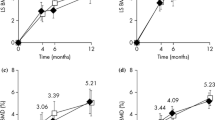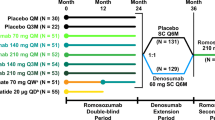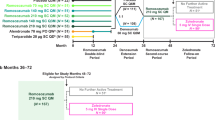Abstract
We examined response to bone mineral density (BMD) gains in the MOVER study following treatment with intravenous (IV) ibandronate 1 mg/month, and investigated the characteristics of a non-responder group. At 1 year, responder rates for patients with BMD increases >0 % were similar with IV ibandronate 0.5 or 1 mg/month and oral risedronate 2.5 mg/day. However, after 3 years, responder rates with BMD increases ≥3 % were highest with ibandronate 1 mg at all bone sites (>80 % at the lumbar spine [L2–L4] and >50 % at all femur sites, which was significantly higher than with risedronate). Non-responders were defined by BMD increases ≤3 % at L2–L4 or ≤0 % at total hip, and ≤50 % reduction in creatinine-corrected urinary collagen type 1 cross-linked C-telopeptide (uCTX) from baseline to 1 year. There were a small number of non-responders in the ibandronate 1 mg group: 3.3 % (10/299) with ≤0 % total hip BMD increase and ≤50 % uCTX reduction from baseline. These non-responders had lower 25-hydroxyvitamin D (25[OH]D) levels than responders, but no differences in kidney function, L2–L4 BMD or bone turnover marker baseline values. Throughout the study, non-responders failed to show any increases in BMD. Our analysis demonstrates significantly higher responder rates with IV ibandronate 1 mg/month than with risedronate at 3 years. A small number of non-responders in the ibandronate group had lower 25(OH)D baseline levels than responders, suggesting that 25(OH)D levels could be a useful indicator of BMD response to therapy.




Similar content being viewed by others
References
Chesnut CH III, Skag A, Christiansen C, Recker R, Stakkestad JA, Hoiseth A, Felsenberg D, Huss H, Gilbride J, Schimmer RC, Delmas PD (2004) Oral ibandronate osteoporosis vertebral fracture trial in North America and Europe (BONE) effects of oral ibandronate administered daily or intermittently on fracture risk in postmenopausal osteoporosis. J Bone Min Res 19:1241–1249
Reginster JY, Adami S, Lakatos P, Greenwald M, Stepan JJ, Silverman SL, Christiansen C, Rowell L, Mairon N, Bonvoisin B, Drezner MK, Emkey R, Felsenberg D, Cooper C, Delmas PD, Miller PD (2006) Efficacy and tolerability of once-monthly oral ibandronate in postmenopausal osteoporosis: 2 year results from the MOBILE study. Ann Rheum Dis 65:654–661
Delmas PD, Adami S, Strugala C, Stakkestad JA, Reginster JY, Felsenberg D, Christiansen C, Civitelli R, Drezner MK, Recker RR, Bolognese M, Hughes C, Masanauskaite D, Ward P, Sambrook P, Reid DM (2006) Intravenous ibandronate injections in postmenopausal women with osteoporosis: one-year results from the dosing intravenous administration study. Arthritis Rheum 54:1838–1846
Eisman JA, Civitelli R, Adami S, Czerwinski E, Recknor C, Prince R, Reginster JY, Zaidi M, Felsenberg D, Hughes C, Mairon N, Masanauskaite D, Reid DM, Delmas PD, Recker RR (2008) Efficacy and tolerability of intravenous ibandronate injections in postmenopausal osteoporosis: 2-year results from the DIVA study. J Rheumatol 35:488–497
Nakamura T, Nakano T, Ito M, Hagino H, Hashimoto J, Tobinai M, Mizunuma H, MOVER Study Group (2013) Clinical efficacy on fracture risk and safety of 0.5 mg or 1 mg/month intravenous ibandronate versus 2.5 mg/day oral risedronate in patients with primary osteoporosis. Calcif Tissue Int 93:137–146
Hagino H, Yoshida S, Hashimoto J, Matsunaga M, Tobinai M, Nakamura T (2014) Increased bone mineral density with monthly intravenous ibandronate contributes to fracture risk reduction in patients with primary osteoporosis: three-year analysis of the MOVER study. Calcif Tissue Int 95:557–563
Sebba AI, Emkey RD, Kohles JD, Sambrook PN (2009) Ibandronate dose response is associated with increases in bone mineral density and reductions in clinical fractures: results of a meta-analysis. Bone 44:423–427
Harris ST, Blumentals WA, Miller PD (2008) Ibandronate and the risk of non-vertebral and clinical fractures in women with postmenopausal osteoporosis: results of a meta-analysis of phase III studies. Curr Med Res Opin 24:237–245
Cranney A, Wells GA, Yetisir E, Adami S, Cooper C, Delmas PD, Miller PD, Papapoulos S, Reginster JY, Sambrook PN, Silverman S, Siris E, Adachi JD (2009) Ibandronate for the prevention of nonvertebral fractures: a pooled analysis of individual patient data. Osteoporos Int 20:291–297
Miller PD, Recker RR, Harris S, Silverman S, Felsenberg D, Reginster J, Day DM, Barr C, Masanauskaite D (2014) Long-term fracture rates seen with continued ibandronate treatment: pooled analysis of DIVA and MOBILE long-term extension studies. Osteoporos Int 25:349–357
Harris ST, Reginster JY, Harley C, Blumentals WA, Poston SA, Barr CE, Silverman SL (2009) Risk of fracture in women treated with monthly oral ibandronate or weekly bisphosphonates: the eValuation of IBandronate Efficacy (VIBE) database fracture study. Bone 44:758–765
Watts NB, Cooper C, Lindsay R, Eastell R, Manhart MD, Barton IP, van Staa TP, Adachi JD (2004) Relationship between changes in bone mineral density and vertebral fracture risk associated with risedronate: greater increases in bone mineral density do not relate to greater decreases in fracture risk. J Clin Densitom 7:255–261
Carmel AS, Shieh A, Bang H, Bockman RS (2012) The 25(OH)D level needed to maintain a favorable bisphosphonate response is ≥33 ng/ml. Osteoporos Int 23:2479–2487
Acknowledgments
All analyses for publication were the responsibility of Chugai Pharmaceutical Co. Ltd. All authors contributed to the manuscript and have approved the final version for submission. The authors acknowledge Dr. Daiva Masanauskaite and Dr. Joseph Kohles of F. Hoffmann-La Roche Ltd. for discussing the results with them. The MOVER study was funded by Chugai Pharmaceutical Co. Ltd. and Taisho Pharmaceutical Co. Ltd. Support for third-party writing assistance for this manuscript was provided by Chugai Pharmaceutical Co. Ltd.
Author information
Authors and Affiliations
Corresponding author
Ethics declarations
Conflict of interest
Tetsuo Nakano has received consulting fees from Asahi Kasei Pharma Corp., Chugai Pharmaceutical Co. Ltd., Daiichi Sankyo Inc., and Teijin Pharma Ltd. Masao Yamamoto, Junko Hashimoto, Masato Tobinai, and Seitaro Yoshida are employees of Chugai Pharmaceutical Co. Ltd. Toshitara Nakamura has received research grants and/or consulting fees from Asahi Kasei Pharma Corp., Astellas Pharma Inc., Banyu Pharmaceutical Co. Ltd., Chugai Pharmaceutical Co. Ltd., Daiichi Sankyo Inc., Eisai Co. Ltd., Eli Lilly Japan K.K., Ono Pharmaceutical Co. Ltd., Takeda Pharmaceutical Co. Ltd., and Teijin Pharma Ltd., and belongs to the Japan Ministry of Health, Welfare and Labor as a councillor for hospital administration and social medical insurance.
About this article
Cite this article
Nakano, T., Yamamoto, M., Hashimoto, J. et al. Higher response with bone mineral density increase with monthly injectable ibandronate 1 mg compared with oral risedronate in the MOVER study. J Bone Miner Metab 34, 678–684 (2016). https://doi.org/10.1007/s00774-015-0717-8
Received:
Accepted:
Published:
Issue Date:
DOI: https://doi.org/10.1007/s00774-015-0717-8




